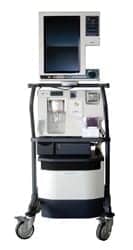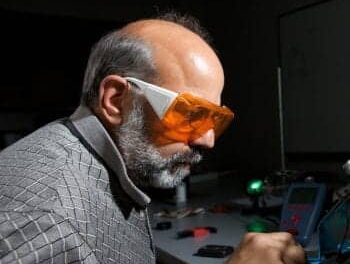Many Hospitals shun in-house service because of the "liability." What liability?

The mystique that surrounds anesthesia machines amazes me. Many people refuse to even consider working on them, and many hospitals insist that the manufacturer provide all the service.
I began repairing anesthesia machines in 1977. I also taught a class on the clinical operation of anesthesia equipment to certified registered nurse anesthetist students at a school of nurse anesthesia. A part of my duties in those first few years was to design, build, and install anesthesia gas scavenger systems on the machines we had because none were provided by the manufacturers. The spontaneous abortions and other undesirable side-effects caused by waste anesthetic gas were just becoming known. Over the years, I became very familiar with the construction, theory, safety devices, and clinical operation of anesthesia machines.
While I no longer turn a wrench, I have for many years managed biomedical equipment technicians (BMETs) who service anesthesia machines. I am have stayed familiar with the machines’ operation, features, safety systems, and shortcomings.
Anesthesia machines provide the life support that critical care ventilators do, but ventilators have fewer alarms and are often placed on unconscious patients with no medical staff present. Plus, a ventilator’s electronically controlled settings and valves are certainly more complex than those on an anesthesia gas machine. True, the job of an anesthesia machine is to take human beings very close to death and (more importantly) allow them to wake up again. But they are so simple! Many hospitals shun in-house service because of the “liability.” What liability? Let me describe anesthesia machines and the ways in which they are used.
How They Work
An anesthesia machine is primarily a pneumatic device that delivers a precisely known variable mixture of oxygen, gases, and an anesthetic agent to a patient.
It is that simple.
There are several major parts to an anesthesia machine: a gas supply (usually wall hoses and onboard cylinders for backup), regulators (to reduce the pressures), flow meters (to adjust the gas flows), a vaporizer (to evaporate and deliver a precise percentage of anesthetic agent), an absorber (to remove carbon dioxide from the patient’s breaths), and a pair of one-way valves (to properly direct the gases through the absorber).
There are many safety systems on an anesthesia machine: a diameter-indexed safety system for compressed-gas hoses, a pin index for tanks, a fail-safe system for oxygen-pressure loss, specially adjusted regulators to automatically change to cylinders if wall pressure is lost, linked flow meters to control flows, mechanical linkage to prevent more than one vaporizer from turning on, keyed filling systems for vaporizers to eliminate misfills, and ventilators engineered to deliver more consistent ventilation.
| Evolution or Devolution?
It is my opinion that anesthesia machines today have evolved very little from 30 years ago. Sure, there are certain safety features that have no doubt saved lives. The ability to deliver anesthetic agent from only a single vaporizer at a time is huge. (This was introduced in about 1980.) Linked flow meters that do not allow hypoxic mixtures to the patient (less than 21% oxygen) have no doubt saved a life here and there. But as for other “features,” I believe that they are designed more to sell newer machines rather than to make anesthesia safer. Virtual displays of fake flow meters on a flat-panel display are no more accurate or informative than looking directly at a real flow meter. And there are certainly more points of failure for the electronic display. In the old days, I worked on totally pneumatic machines. There was no power cord, no batteries, and the only thing electrically operated was the heart monitor. The machine was very safe, had all of the necessary safety features, and never failed except in the case of physical damage (cleaning crews, etc). The electronics added to anesthesia machines did accomplish something—they made troubleshooting and repairing the machine while the patient is on the table almost impossible. When they lock up (and they lock up more often than the pneumatic machines), they totally quit working. When that happens, the only thing to do is to find a fully working spare and swap machines. The failed machine can then be troubleshot at leisure. I believe that this is not evolution, but devolution. I try to be vigilant for my personal prejudices (especially since I’ve been doing this for a long time and don’t want to be seen as just another old guy who doesn’t like progress). But after careful thought, I believe the older, totally pneumatic anesthesia gas machines were not only more reliable, but just as safe—if not safer—than the machines of today. I think it is time to evaluate what are value-added improvements and what constitutes bells and whistles to sell new machines. —PL |
Low Accident Rate
There is no more supervised and monitored time during a patient’s stay in the hospital than in the operating room (OR).
An OR is the most densely populated area of the hospital, in terms of staff and equipment. There are always one or two anesthesia personnel, a surgeon or two, a scrub nurse or two, a couple of circulating nurses, equipment operators, and several other assorted personnel in the room. The number of staff in an OR can often number eight or more. It is very difficult for anesthesia machine-related accidents to occur during surgery for several reasons, including the following:
• There is a full-time, specially trained person dedicated to keeping the patient at just the right level of anesthesia—not too deep and not too light.
• Vital-sign monitors, oxygen analyzers, anesthetic gas monitors, and pulse oximeters all are monitoring the patient’s parameters. The anesthesia machine, the ventilator, and all of the associated patient monitors feature alarms, which provide a level of safety and redundant security beyond that of the anesthesia staff. And in case the electronic equipment isn’t enough, there is always a stethoscope monitoring the heartbeat and breathing sounds directly.
• The anesthesia machine itself has several built-in safety devices. Flow meters cannot deliver less than 21% oxygen. Nitrous oxide is shut off if the oxygen pressure fails. Vaporizers are linked so that no more than a single agent can be delivered at any time. An assortment of gauges and dials give the anesthesia personnel ready information about the state of the machine and the gases that it administers.
• Each of these machines, monitors, and systems has its own preuse checkout procedure, which, if followed regularly and often, will virtually ensure that no equipment fails during a case.
It would be logical that most incidents would occur at the start of a case, since the patient is being put to sleep, intubated, and hooked up to all of the equipment. But surprisingly, researchers1 found that most incidents occurred during the middle of a case, which also is the time when the anesthesia personnel have the least to do and can be less diligent in their attention to the patient. Indeed, only 2% of the failures (6 out of 359) documented in the study were due to machine failure of some sort. It seems an anesthesia machine is as safe as the person using it.
No Room for Error
A certain type of repair person is needed for anesthesia service. The machines are straightforward, but the consequences of failure can be devastating—they are among only four or five items in the entire hospital that are truly “life support” (others include ventilators, heart–lung bypass pumps, and pacemakers). The person who works on anesthesia machines must, above all, be someone who always follows procedures. Diligently following all checkout procedures and postrepair tests is the final critical step every time you touch a machine. These checkouts are designed to determine whether a repair is done correctly or not. Life-support equipment is no place to cut corners or rush through a repair or preventive maintenance check.
It doesn’t require a senior-level BMET to service anesthesia machines, though. I have taken recent graduates from a BMET school and sent them to a manufacturer’s school, and they have been very successful when working under the guidance of a seasoned BMET. It is the personality and attention to detail that determines their success. There is no room for error in anesthesia service.
Patrick K. Lynch, CBET, CCE, MBA, is director of biomedical engineering at Northside Hospital in Atlanta and is available at [email protected].
Reference
1. Cooper JB, Newbower R, Long C, et al. Preventable anesthesia mishaps: a study of human factors. Anesthesiology. 1978;49(6):399–406.



